So, let's start, we will use:
- System: Ubuntu Server 12.04;
- DVR: Zoneminder;
- Cameras: analog and ip dish;
- Video capture card: PCI bridge: Hint Corp HiNT HB4 PCI-PCI Bridge (PCI6150)
- The main requirement: to raise the video surveillance server for production
Aypishniki to be used in our how-to:
192.168.110.151 - the address of our DVR itself;
192.168.107.103 - address of the ip camera.
1) Detailed installation instructions for Ubuntu 12.04 server. Step-by-step screenshots are attached.
To install Ubuntu 12.04 Server, download the iso image on the page, burn it to a CD and boot from it. The first window, select the installation language, in our case I choose Russian:
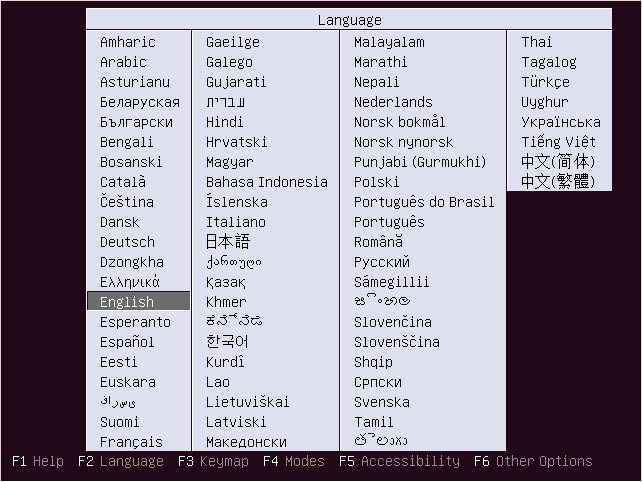
Run the installation of Ubuntu 12.04:
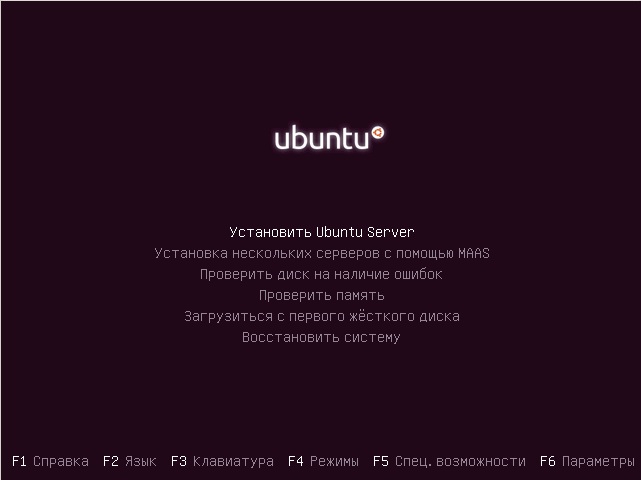
Choose a country:
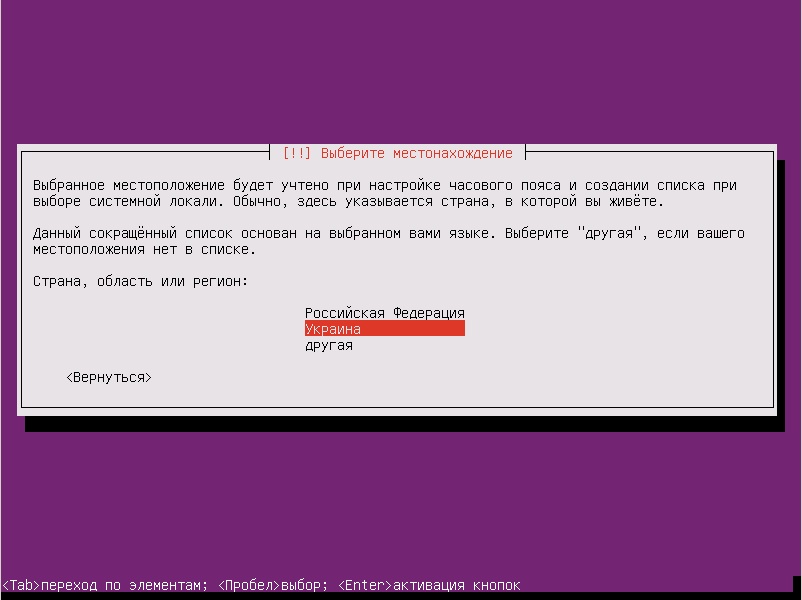
We do not agree with the automatic detection of the keyboard:
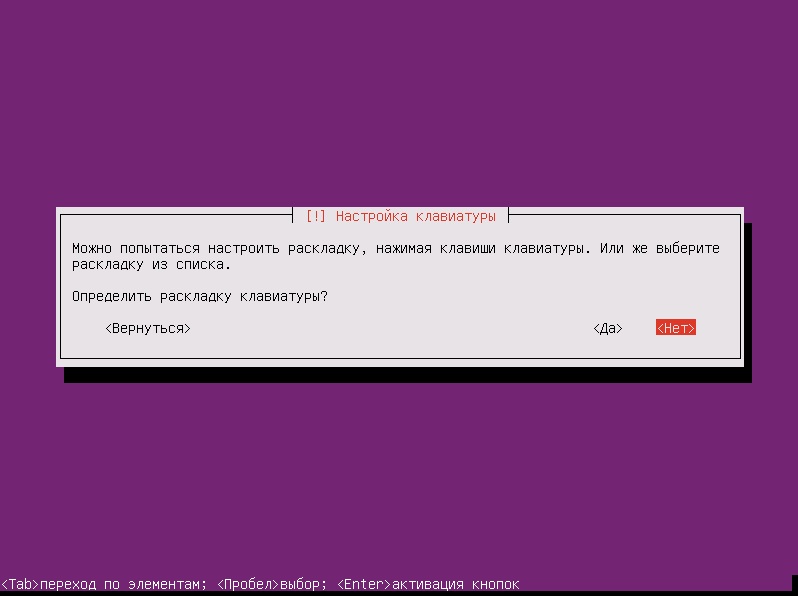
Select the layout language:

Choose a keyboard switching method, I prefer Ctrl + Shift, in your case it may be different:

The network will be configured by dhcp:

It does not suit us, therefore, we press the “Return” button

Select "Manually configure the network"

Next, in the proposed, windows, we write the settings of our network, gateway and dns. The next window will offer to write the name of the computer in my case, this is a tester. We write user name:

Enter the password, after writing it in a notebook:

Next is the automatic setting of the time zone and will ask if this is the correct time zone:

Today I will choose automatic disk partitioning:

Choose a disk:
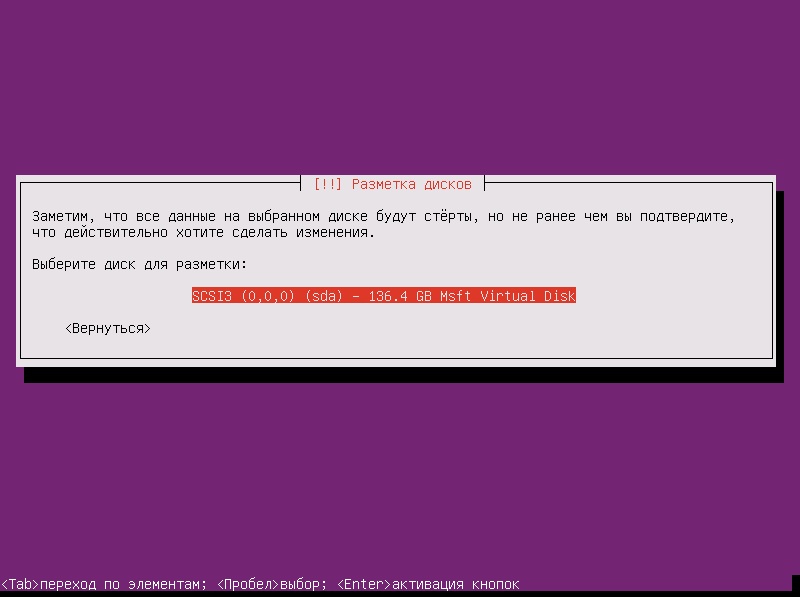
and write the changes:
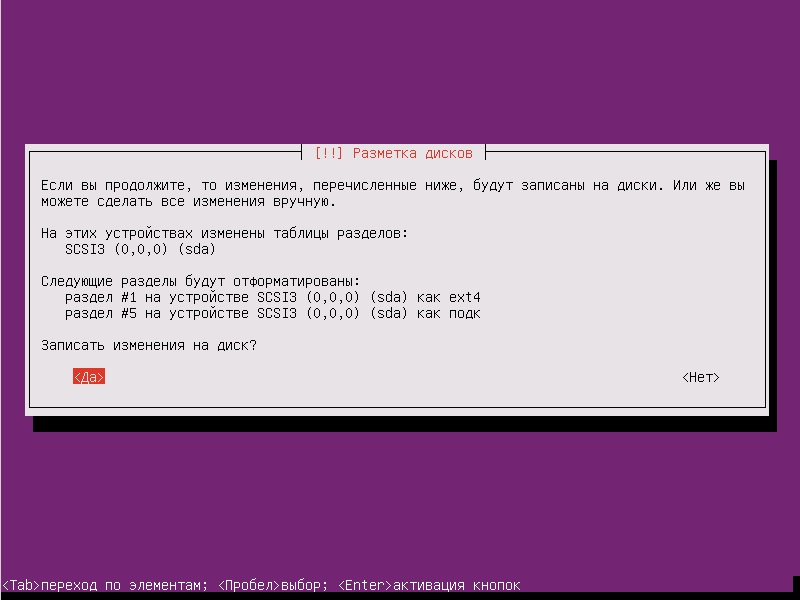
This is followed by the installation process itself Ubuntu 12.04 Server:
During the installation process, if you use a proxy, you must specify the address of the proxy server:
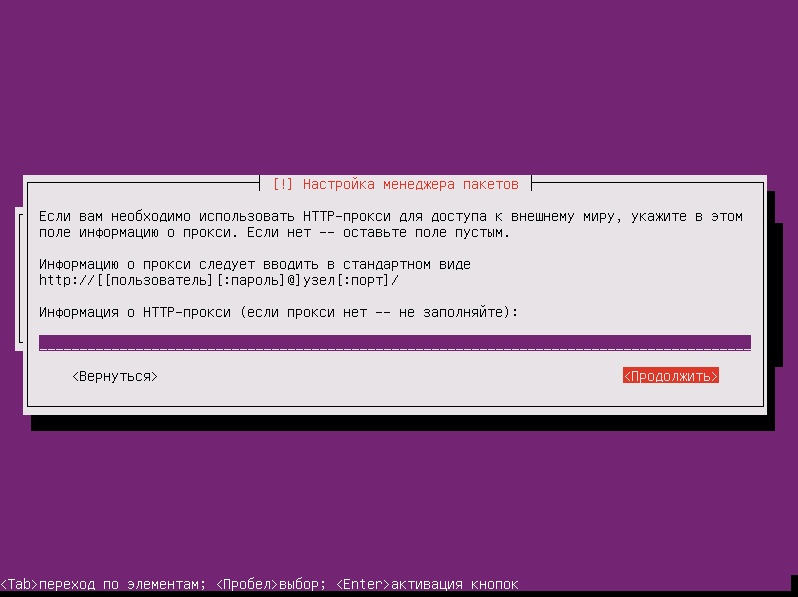
Disable updates, because they can cause system instability:

Well, we have almost completed the installation of Ubuntu 12.04 Server and have reached the stage of choosing the purpose of our system. The choice of items in this step depends on what role your new Ubuntu server will play - it can be both a database server and a mail server, etc. In our case, it is necessary to choose the lamp and openssh server.
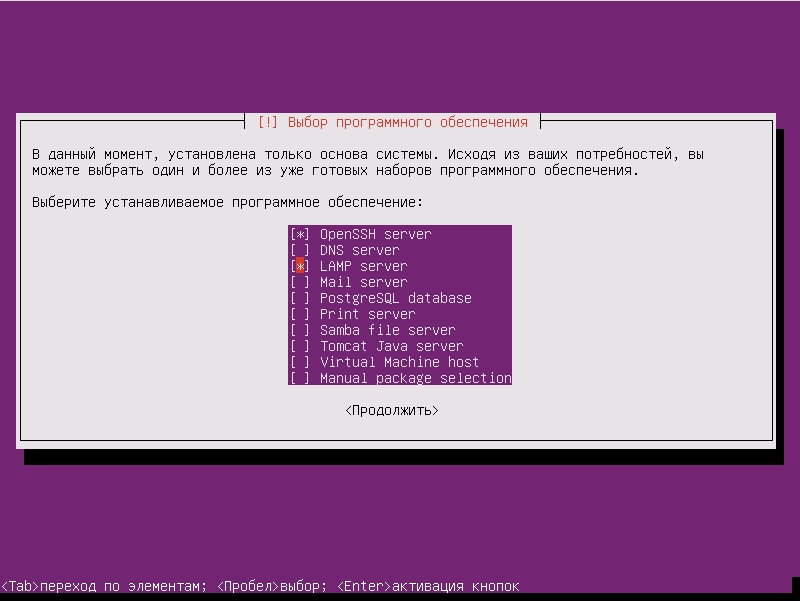
Enter the root password for mysql:
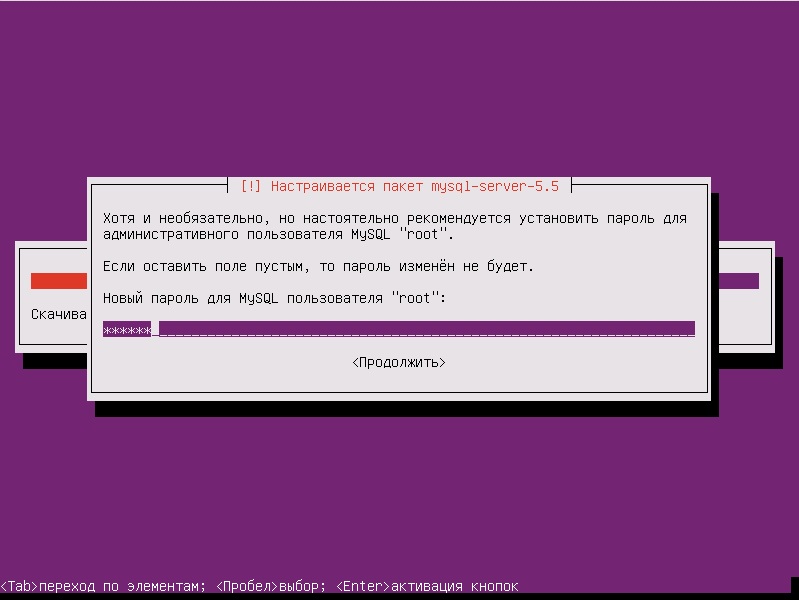
At the last stage, the installer will offer to install the system loader in the master boot record:

A few seconds and you can remove the disk from Ubuntu 12.04 Server from the drive and click on "Continue":

When the server is successfully overloaded, you can log in using your username and password.
2) Installing and configuring the Zoneminder dashcam
Zoneminder 1.25.0 on Ubuntu 12.04
For successful work, we need to install the OpenSSH Server, and LAMP Server, which we did in the previous paragraph.
1. Login as root:
#sudo su
2. Install updates and reboot:
$apt-get update $apt-get upgrade $apt-get dist-upgrade $reboot
3. We need: Static aypishnik
$nano /etc/network/interfaces
4. There we write:
auto eth0 iface eth0 inet static address 192.168.110.151 netmask 255.255.255.0 gateway 192.168.110.220 dns-nameservers 192.168.110.5 192.168.110.6
5. Save the document.
6. Reboot:
$reboot
7. Proceed directly to installing the zoneminder:
#sudo su $apt-get install zoneminder
8. Edit the Zoneminder script itself, since it does not start automatically at boot:
$nano /etc/init.d/zoneminder
We paste in the document before the line “zmfix -a”, just like this - sleep 15.
9. Save the document.
10. Making a symbolic reference:
$ln -s /etc/zm/apache.conf /etc/apache2/conf.d/zoneminder.conf
11. Restarting the web server:
$/etc/init.d/apache2 force-reload
12. Add a user from whom the video will be manipulated:
$adduser www-data video
13. Install cambozola to support video playback:
$cd /usr/src && wget http://www.charliemouse.com:8080/code/cambozola/cambozola-latest.tar.gz $tar -xzvf cambozola-latest.tar.gz $cp cambozola-0.92/dist/cambozola.jar /usr/share/zoneminder
14. Add certificates for the web server:
$make-ssl-cert generate-default-snakeoil
15. Activate them:
$a2enmod ssl
16. Activate the default ssl-virtual host:
$a2ensite default-ssl
17. Restart the web server:
$service apache2 restart
18. For the successful use of https we do the following:
$nano /etc/cron.daily/ntpdate
19. Paste these two lines:
#!/bin/sh ntpdate ntp.ubuntu.com
20. Save the document.
21. Giving rights to it:
$chmod 755 /etc/cron.daily/ntpdate
22. We edit the sysctl.conf file in order to let the kernel know how much memory we will use under the zoneminder (otherwise the black screen will be the case):
$nano /etc/sysctl.conf
23. Insert into the bottom of the document the following two lines:
kernel.shmall = 134217728 kernel.shmmax = 134217728
24. Pass these values to the kernel:
$echo 134217728 >/proc/sys/kernel/shmall $echo 134217728 >/proc/sys/kernel/shmmax
25. Rebooting:
$reboot
26. Go to Zoneminder:
http:
27. In the console, press the “Options” button
LANG_DEFAULT Default language used by web interface, set the value “ru_ru”
The ability to see the Russian interface.
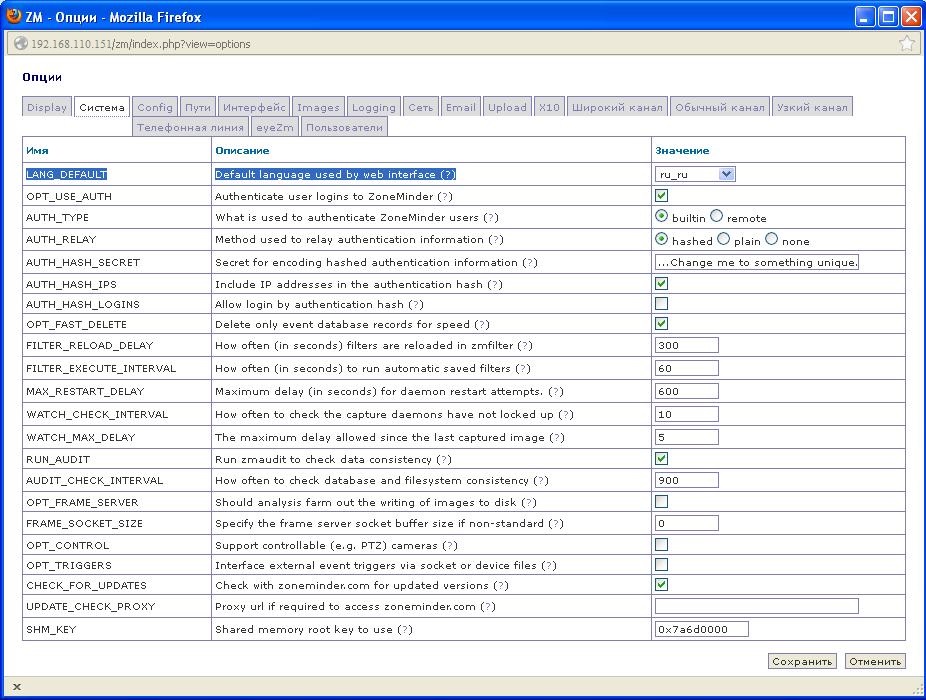
28. Click Add Monitor.
29. And fill two columns with options.
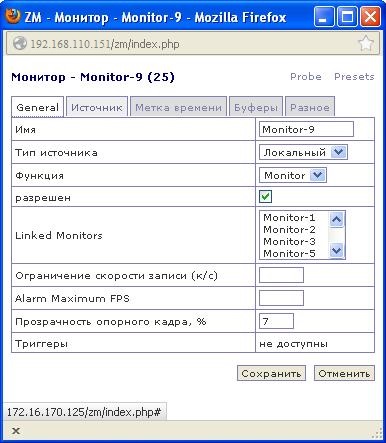

30. When viewing the monitor, we will most likely see a black screen, after playing around with the options, it is possible to see the image, but with great interference.
31. How to solve this problem, I will tell in the next item to configure the cameras.
32. Everything is a bit simpler with ip camera, go to the management console of our ip camera, we need three parameters: 1) username and password to access the camera via http, 2) path to the camera, 3) its resolution.
33. Go to the camera control console through a browser:
192.168.107.10334. Add a new user (for example, test with the password test):

35. We look at the resolution:

Yeah, we have it 320x240.
36. We look now the way to the camera>
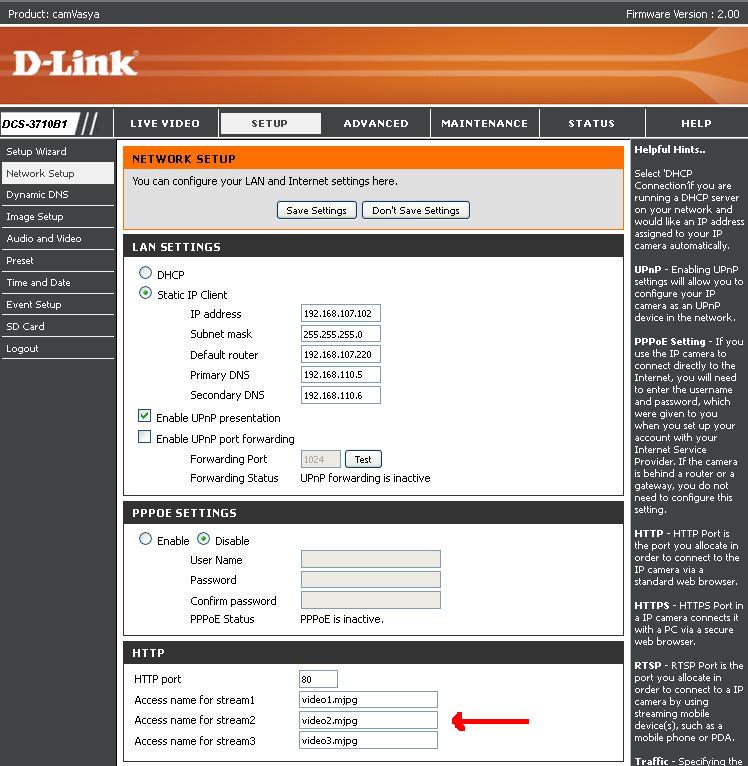
37. Click on Zoneminder, “Add Monitor”. We enter the following options on the “General” and “Source” tabs:
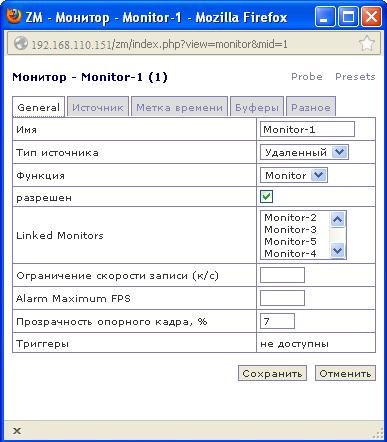
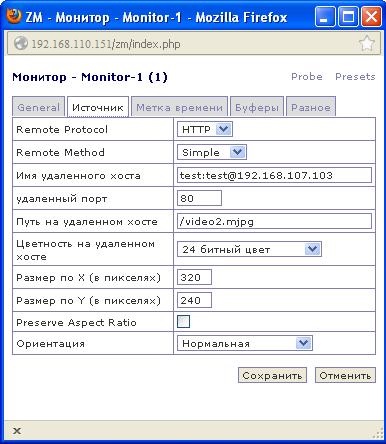
3) Setting up analog cameras on the PCI bridge video capture card: Hint Corp HiNT HB4 PCI-PCI Bridge (PCI6150).
1. Install the following packages:
$apt-get install v4l-conf libv4l-0 v4l2ucp v4l-conf v4l-utils
2. We look, whether our video devices were defined at all:
$ls -l /dev/video*
Must get a conclusion
crw-rw
So our analog video output devices are defined in the system.
3. We look at the information about our device (all analog video devices are stored in the form / dev / video):
$v4l-info /dev/video0 | head -n 9 | grep "^card"
We get this conclusion:
card : "BT878 video ( *** UNKNOWN/GENER"
That was the reason why our device was not correctly displayed in Zoneminder. This is not good, because The driver parameters of our device are not transferred to the kernel, we look further.
4. We need to unload the module:
$rmmod bttv
5. What we get a non-affirmative answer:
Error: Module bttv is in use
I spent a lot of time on rebuilding the kernel and other nonsense, the answer was simple. Our analog device was used, and it was used by the DVR, so that we do so.
6. Stop the zoneminder:
$/etc/init.d/zoneminder /stop
7. We try to unload the module:
$rmmod bttv
8. As we see the command, it swallowed normally, so we try to transfer the parameters to the kernel manually:
modprobe -v bttv card=0x69,0x69,0x69,0x69,0x69,0x69,0x69,0x69,0x69 tuner=-1,-1,-1,-1,-1,-1,-1,-1,-1 autoload=0
9. We look at the information about our device (all analog video devices are stored in the form / dev / video):
$v4l-info /dev/video0 | head -n 9 | grep "^card"
And now we get the following conclusion:
card: “BT878 video (ProVideo PV143)”
Which means that everything turned out great and the drivers applied.
10. We give just in case the rights to the cameras:
$chmod a+rwx /dev/video*
11. Start Zoneminder:
$/etc/init.dzoneminder start
12. Go to Zoneminder:
192.168.110.151/zmWe check our analog camera and we can make sure that everything is fine with the image and we can safely observe it in our DVR. Further, this whole thing is necessary for us automatically, that would rise in the kernel, without manual launch.
13. Create a bttv.conf file:
$nano /et c/modprobe.d/bttv.conf
14. Insert into it the following content:
alias char-major-81-0 bttv alias char-major-81-1 bttv alias char-major-81-2 bttv alias char-major-81-3 bttv alias char-major-81-4 bttv alias char-major-81-5 bttv alias char-major-81-6 bttv alias char-major-81-7 bttv alias char-major-81-8 bttv options bttv card=0x69 tuner=-1 autoload=0 i2c_scan=0 i2c_hw=-1 options bttv card=0x69,0x69,0x69,0x69,0x69,0x69,0x69,0x69 tuner=-1,-1,-1,-1,-1,-1,-1,-1 autoload=0
15. Reboot:
$reboot
16. We admire the result:

4) Possible problems to be encountered when performing my HOW-TO.
1. Russian font in the console:
• in any text editor with root privileges, add the line FRAMEBUFFER = Y to the /etc/initramfs-tools/initramfs.conf file. This can also be done by running the following commands:
$sudo -i $echo 'FRAMEBUFFER=Y' >> /etc/initramfs-tools/initramfs.conf $exit
• Update ramdisk image of the kernel initialization period (initrd):
$update-initramfs –u
• Field of these manipulations settings made by the command:
sudo dpkg-reconfigure console-setup
• at last they will start working: Russian fonts will show everything from the very beginning - i.e. even a request for checking disks (arising during the kernel initialization process) will be displayed in Cyrillic, rather than squares.
2. Ubuntu does not see the monitor.
Not all types of monitors see Ubuntu after installation, most often you will see “Non-optimal mode 1024x768. The optimal mode is 1240 x 860 ":
• Go / etc / default / grub
• Remove comments from the line
GRUB_GFXMODE=640x480
• Update the bootloader
$update-grub
• reboot the system
$reboot
3) Sources used to implement this project